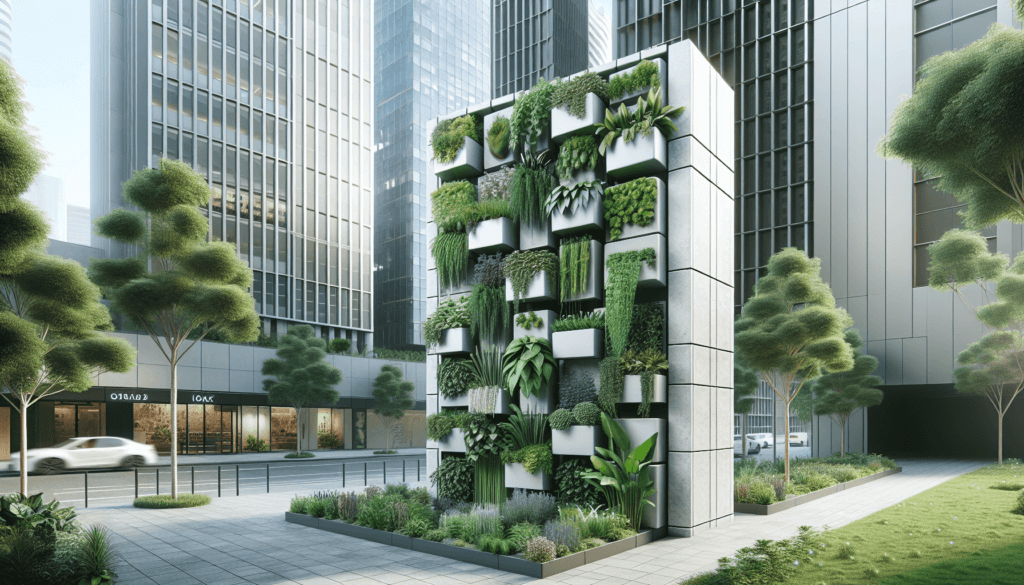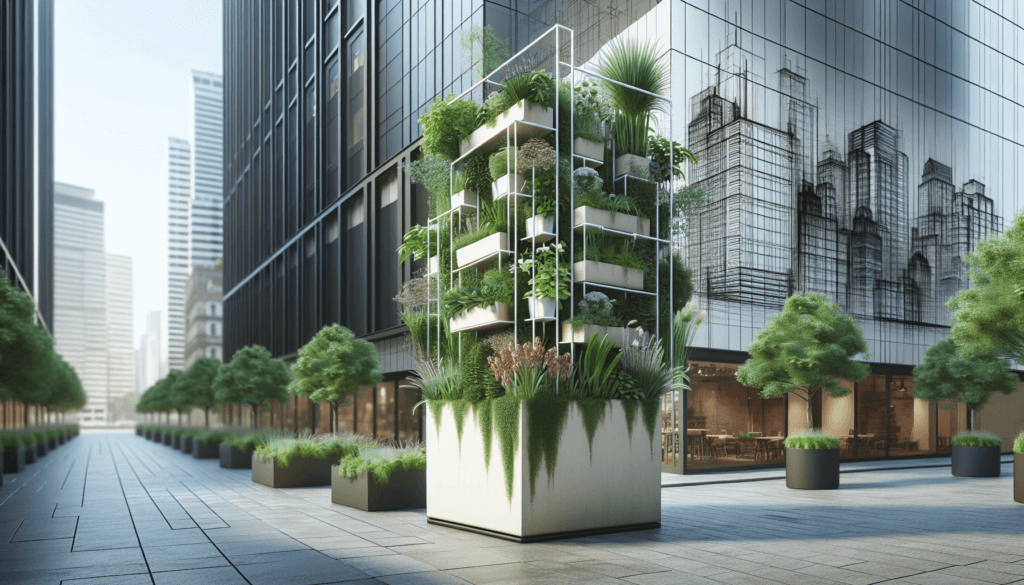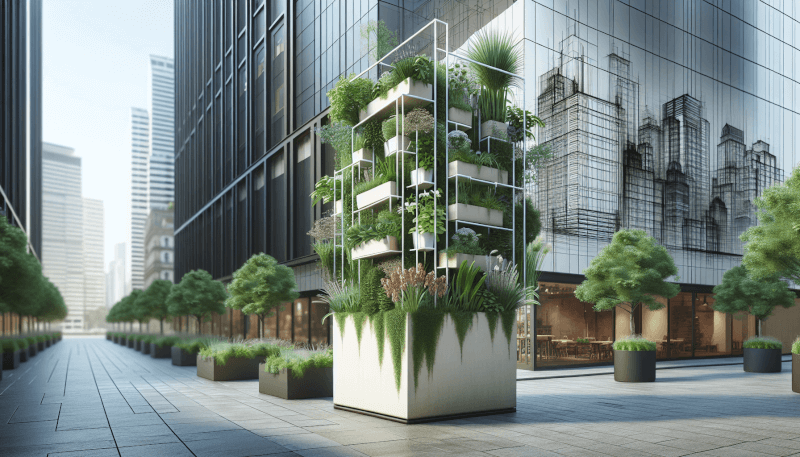If you’re an urban gardener looking to make the most of your limited space, then vertical planters are the solution you’ve been waiting for. These innovative structures allow you to maximize your garden’s potential by utilizing vertical wall space. With vertical planters, you can grow an abundance of plants, flowers, and herbs, even in the smallest of urban spaces. Say goodbye to overcrowded pots and hello to a lush and thriving garden that will transform your urban oasis into a green paradise. So, whether you have a small balcony or an expansive rooftop, it’s time to unlock the hidden potential of your urban garden with vertical planters. Urban gardening can be a challenge, especially when it comes to limited space. However, the use of vertical planters provides an effective solution to this problem. In this article, we will explore the many benefits of vertical planters, discuss how to choose the right one for your needs, delve into different vertical planting techniques, offer tips for selecting suitable plants, provide guidance on preparing and installing vertical planters, and share essential plant care and maintenance tips to help you achieve maximum yield. We will also explore creative design ideas for vertical planters, discuss common challenges and how to overcome them, and showcase inspiring examples of successful vertical gardens in urban spaces.
Benefits of Vertical Planters
Increased Growing Area
One of the primary benefits of vertical planters is the increased growing area they provide. By utilizing vertical space, you can grow more plants in a smaller footprint. This is especially beneficial in urban gardens, where space is often limited. Vertical planters allow you to maximize the use of available space, enabling you to grow a wider variety of plants and increase your overall yield.
Utilization of Vertical Space
In urban environments, where horizontal space is often scarce, utilizing vertical space is crucial. Vertical planters allow you to make the most of limited space by growing plants vertically instead of horizontally. This not only maximizes the use of available space but also opens up new possibilities for gardening in areas that were previously unused or overlooked. Vertical planters can be installed against walls, fences, or even hung from structures, making it easy to transform any vertical surface into a productive garden.
Enhanced Aesthetics
Vertical planters not only provide functional benefits but also enhance the aesthetics of any garden or outdoor space. They add a unique visual element and bring life and greenery to otherwise dull and barren walls. The vertical arrangement of plants creates a visually appealing display that can be customized to suit your personal style and preferences. Whether you prefer a lush green wall or an array of colorful flowers, vertical planters offer endless possibilities for creating visually stunning gardens.
Improved Air Quality
Plants are natural air purifiers, and the more plants you have, the better the air quality. Vertical planters allow you to introduce a greater number of plants into your space, promoting improved air quality. As plants absorb carbon dioxide and release oxygen, they help reduce air pollution and create a healthier and fresher environment. In urban areas, where air pollution is a major concern, incorporating vertical planters can have a significant impact on air quality, benefiting both you and the surrounding community.
Reduced Risk of Pests and Diseases
Another advantage of vertical planters is the reduced risk of pests and diseases. When plants are grown vertically, they are less susceptible to common garden pests and diseases. Since the plants are elevated, they are less accessible to ground-dwelling pests, and proper spacing between plants helps promote better air circulation, reducing the risk of diseases caused by damp and stagnant conditions. Vertical planters also make it easier to monitor and address any pest or disease issues that may arise, as the plants are at eye level, making routine inspections and maintenance tasks more convenient.
Choosing the Right Vertical Planter
Consider the Available Space
Before choosing a vertical planter, it’s essential to assess the available space in your garden or outdoor area. Consider the dimensions and layout of the space, taking note of any walls, fences, or structures that could be used to install the vertical planter. Measure the height, width, and depth of the available space to ensure that the chosen planter will fit properly and allow for adequate plant growth.
Evaluate Drainage and Watering Needs
Different vertical planters come with varying drainage systems and watering needs. Consider the drainage capabilities of the planter and ensure that it allows excess water to drain effectively to prevent waterlogging and root rot. Additionally, consider the watering requirements of the plants you intend to grow and choose a planter that can accommodate those needs. Some vertical planters may require manual watering, while others have built-in irrigation systems for automated watering.
Select the Desired Material
Vertical planters are available in a wide range of materials, including plastic, ceramic, metal, and wood. Each material has its own set of advantages and disadvantages. Plastic planters are lightweight, affordable, and easy to maintain, but may not offer the same aesthetic appeal as ceramic or metal planters. Wood planters provide a rustic and natural look, but may require more maintenance and can degrade over time. Consider the durability, aesthetic appeal, and maintenance requirements of each material before making your selection.
Determine the Plant Compatibility
Different plants have different growth habits and requirements. Before choosing a vertical planter, consider the plants you wish to grow and ensure that they are compatible with vertical planting. Some plants, such as climbers and trailing varieties, are well-suited for vertical planters, while others may not thrive in this environment. Research the specific plants you are interested in and choose a planter that can accommodate their growth habits and requirements.
Assess Maintenance Requirements
Lastly, consider the maintenance requirements of the chosen vertical planter. Some planters may require more frequent watering and fertilizing, while others may need occasional cleaning or repairs. Consider your available time and resources for plant care and choose a planter that aligns with your maintenance capabilities. Additionally, consider the longevity of the planter and whether it will require replacement or refurbishment over time.

Vertical Planting Techniques
Trellis Systems
Trellis systems are a popular method of vertical planting and are especially suitable for climbing plants, such as tomatoes, beans, or cucumbers. A trellis consists of a framework of vertical posts or rods with horizontal supports, providing a structure for plants to climb. Plants can be tied or trained onto the trellis as they grow, allowing them to extend vertically rather than spread horizontally. Trellis systems offer excellent support and stability for climbing plants, promoting better airflow and easier access for harvesting.
Stacked Planters
Stacked planters, also known as vertical stackable pots or tower planters, are an innovative vertical planting technique that utilizes a series of stacked containers to create a vertical garden. Each container has multiple planting pockets, allowing you to grow several plants in a compact space. Stacked planters are versatile and can be used in various settings, from small balconies to large gardens. They offer excellent space optimization and are particularly suitable for growing herbs, flowers, and small vegetables.
Pocket Planters
Pocket planters, also referred to as living walls or vertical garden panels, consist of a framework with multiple pockets or planting cells for individual plants. These planters are typically designed to be mounted to walls or fences, creating a lush green vertical garden. Pocket planters are ideal for smaller plants and are commonly used for growing herbs, succulents, and trailing vines. They offer a visually stunning display, especially when arranged in various colors and textures.
Living Walls
Living walls, also known as green walls or vegetal walls, are vertical plantings that cover entire walls or surfaces with a diverse range of plants. Living walls can be created using a variety of methods, such as modular systems, felt pockets, or hydroponics. They are often used in both indoor and outdoor environments to enhance aesthetics and improve air quality. Living walls provide a stunning display of plants and can transform any dull wall into a vibrant and eye-catching focal point.
Hydroponic Systems
Hydroponic systems utilize water-based solutions instead of soil for growing plants. In vertical hydroponic systems, plants are typically grown in vertical stacks or troughs, with nutrient-rich water flowing through to provide essential nutrients and support plant growth. Hydroponic systems are highly efficient, allowing for faster growth and higher yields compared to traditional soil-based gardening. They are often used in indoor gardens or areas with limited soil availability, making them an excellent choice for urban gardening.
Selecting Suitable Plants for Vertical Planters
Consider Sunlight Requirements
When selecting plants for vertical planters, it’s crucial to consider their sunlight requirements. Some plants thrive in full sun, while others prefer partial or even full shade. Assess the available sunlight in your garden or outdoor area and choose plants that are well-suited to the light conditions. Be mindful of any nearby structures or trees that may cast shade at certain times of the day and select plants accordingly.
Choose Plants with Compact Growth Habits
Since vertical planters have limited space, it’s important to choose plants with compact growth habits. Look for varieties that are known for their vertical growth patterns or have a naturally upright habit. Avoid plants that tend to sprawl or spread horizontally, as they may overcrowd the planter and limit the growth of other plants. Compact varieties of vegetables, herbs, and flowers are excellent choices for vertical planters.
Evaluate Soil and Water Needs
Different plants have varying soil and water needs, so it’s essential to choose plants that have similar requirements. Consider the type of soil or growing medium used in your vertical planter and select plants that can thrive in that environment. Additionally, consider the watering needs of the plants and ensure that they are compatible with the watering system in place. Plants with similar water and soil requirements will be easier to maintain and ensure optimal growth.
Assess Climbing and Trailing Abilities
Vertical planters offer a unique opportunity to grow climbing or trailing plants. These plants can add height and visual interest to your vertical garden. When selecting plants, consider their natural climbing or trailing abilities and choose varieties that will thrive in the vertical planter environment. Climbing plants such as tomatoes, peas, or grapes can be trained onto trellises or stakes, while trailing varieties like trailing petunias or ivy can cascade down from pocket planters or living walls.
Account for Wind and Exposure
In urban environments, wind and exposure can significantly impact the success of your vertical garden. Consider the wind patterns in your garden or outdoor area and choose plants that can tolerate or thrive in windy conditions. Some plants have sturdy stems and are more resistant to wind damage, while others may require additional support or protection. Additionally, consider the exposure levels of your vertical planter to sun, heat, or cold, and select plants that are well-suited to those conditions.

Preparing and Installing Vertical Planters
Determining Installation Location
Before installing your vertical planter, carefully consider the location. Assess the available space, taking note of factors such as sunlight exposure, wind patterns, and accessibility. Choose a location that provides the necessary light conditions for the plants you intend to grow and consider how wind or exposure may affect plant health. Additionally, ensure that the chosen location allows for easy access and maintenance.
Preparing the Supporting Structure
Depending on the type of vertical planter you have selected, you may need to prepare a supporting structure. For trellis systems, ensure that the vertical posts or rods are securely anchored into the ground or fixed to a fence or wall. Stacked planters may require a stable base or framework to prevent toppling. Pocket planters and living walls may need additional brackets or hooks to ensure proper mounting. Follow the manufacturer’s instructions for preparing the supporting structure and ensure that it is sturdy and secure.
Ensuring Proper Drainage
Proper drainage is essential for the health of your plants, so it’s crucial to ensure that your vertical planter has adequate drainage. Check that the planter or individual pockets have drainage holes to allow excess water to escape. If necessary, add additional drainage holes to prevent waterlogging. Additionally, consider placing a layer of gravel or small stones at the bottom of the planter to enhance drainage and prevent soil compaction.
Choosing the Right Growing Medium
The growing medium you choose for your vertical planter will play a crucial role in plant health and growth. Depending on the type of planter, you may opt for soil-based mediums, soilless mixes, or even hydroponic solutions. Research the specific needs of your chosen plants and select a growing medium that will provide adequate nutrients, water retention, and aeration. Ensure that the chosen medium is lightweight enough to prevent undue stress on the supporting structure.
Planting Techniques for Vertical Planters
Planting techniques for vertical planters may vary depending on the type of planter and the specific plants you are growing. When planting in trellis systems, carefully position the plants at the base of the trellis and secure them with ties or plant clips as they grow. Stacked planters typically require filling each pocket with the desired growing medium and planting one or two seedlings per pocket. In pocket planters and living walls, place each plant in its designated pocket or cell, ensuring that the roots are properly covered with the growing medium. Follow the specific planting instructions for your chosen vertical planter to ensure successful establishment and growth.
Plant Care and Maintenance
Watering Strategies
Proper watering is crucial for the health and success of your plants in vertical planters. Depending on the type of planter and plants, watering strategies may vary. When manually watering, ensure that you provide enough water to thoroughly hydrate the roots while allowing excess water to drain. Test the soil or growing medium moisture levels regularly to determine when watering is necessary. Consider using moisture meters or finger tests to determine moisture levels. Automated irrigation systems may also be utilized for consistent and efficient watering, especially in larger vertical gardens.
Nutrient Management
Plants in vertical planters require adequate nutrients to thrive and produce high yields. Regularly fertilize your plants to ensure they receive the necessary nutrients. Choose fertilizers specifically formulated for the types of plants you are growing and follow the recommended application rates. Consider using slow-release fertilizers or organic alternatives to provide a steady supply of nutrients over time. Monitoring the nutrient levels in the soil or growing medium and making adjustments as needed will help ensure optimal plant health.
Pruning and Training
Pruning and training are essential maintenance tasks for vertical planters. Regularly inspect your plants and remove any dead, damaged, or diseased foliage to prevent the spread of pests or diseases. Additionally, use pruning techniques to control the growth and shape of your plants. With climbing plants, guide their growth by tying or training them onto the trellis or supporting structure. Encourage lateral branching for bushier plants and remove any excessive growth that may overcrowd the planter.
Pest and Disease Control
Despite the reduced risk of pests and diseases in vertical planters, it’s essential to remain vigilant and address any issues promptly. Regularly inspect your plants for signs of pests or diseases, such as yellowing leaves, spots, or unusual growth. If pests are present, consider using organic or chemical pest control methods to eliminate them. In the case of diseases, remove infected plants or areas promptly to prevent further spread. Creating a healthy and balanced environment for your plants through proper watering, fertilizing, and maintenance will help minimize the risk of pest and disease problems.
Seasonal Maintenance
Vertical planters may require additional seasonal maintenance to ensure optimal plant health and overall garden success. With the change of seasons, assess your plants’ needs and make any necessary adjustments. Consider adjusting watering schedules, fertilization rates, and pruning techniques to accommodate seasonal changes in light, temperature, and humidity. Additionally, be prepared for frost or extreme weather events by protecting your plants or moving them indoors if necessary. Regularly cleaning and maintaining your vertical planters will also help extend their lifespan and ensure the best possible growing conditions for your plants.

Maximizing Yield in Vertical Planters
Crop Selection for High Yield
Selecting crops that are known for their high yields is an effective way to maximize productivity in vertical planters. Leafy greens such as spinach or lettuce, compact varieties of cucumbers or tomatoes, and herbs like basil or parsley are excellent choices. Consider the growth habits, spacing requirements, and suitability for vertical planting of each crop to determine which ones will provide the highest yield in your specific conditions. Be open to experimenting with different crops and varieties to find what works best for your vertical garden.
Succession Planting
Succession planting is a technique that involves planting new crops as soon as the previous ones are harvested, ensuring a continuous harvest throughout the growing season. In vertical planters, where space is limited, succession planting becomes even more valuable. As you harvest mature plants, remove them and replant with new seedlings or transplants. This technique allows you to make the most of the available space and maximize your overall yield. Consider the average maturity times of different crops and plan your succession planting schedule accordingly.
Practicing Intensive Gardening Techniques
Intensive gardening is a method of densely planting crops to optimize space and yield. In vertical planters, practicing intensive gardening techniques is particularly effective. Instead of spacing plants far apart, densely plant them to fully utilize the available space. Be mindful of the specific crop’s spacing requirements and ensure that you provide adequate nutrients, water, and airflow. Some plants may benefit from vertical trellising or stake support to prevent overcrowding and enhance productivity.
Optimizing Plant Spacing
Although intensive gardening involves densely planting crops, it’s important to optimize plant spacing to ensure healthy growth and maximum yield. Each plant requires a certain amount of space for proper root development, foliar growth, and nutrient uptake. Overcrowding can lead to competition for resources and hinder plant growth. Additionally, proper spacing allows for better airflow and reduces the risk of pest and disease problems. Research the recommended spacing requirements for each crop you are growing and adjust planting densities accordingly.
Utilizing Companion Planting
Companion planting is a technique that involves planting different crops together to create beneficial growing conditions. In vertical planters, companion planting can be effectively utilized to maximize space and improve overall garden health. Choose compatible plant combinations that can mutually benefit each other. For example, planting marigolds or nasturtiums alongside vegetables can help repel pests, while growing climbing plants alongside low-growing crops can provide shade and moisture regulation. Companion planting helps create a biodiverse environment and promotes natural pest control and soil fertility.
Creative Design Ideas for Vertical Planters
Vertical Garden Art
Vertical planters offer an excellent opportunity to incorporate artistic elements into your garden. Consider using plants with different colors, textures, and shapes to create visually stunning designs. Experiment with arranging plants in specific patterns or designs, such as geometric shapes or intricate motifs. Vertical garden art can serve as a focal point or a unique decorative feature in any outdoor space, adding a touch of creativity and beauty.
Colorful Plant Combinations
Play with color in your vertical planters by selecting plants with vibrant blooms or foliage. Consider using complementary or contrasting colors to create eye-catching displays. For example, combine red and green plants for a classic color combination, or create a monochromatic display using different shades of the same color. Colorful plant combinations add visual interest and can create a sense of vibrancy and liveliness in your vertical garden.
Mixing Flowers and Vegetables
Vertical planters offer the opportunity to mix both flowers and vegetables, creating a functional yet beautiful garden. The combination of flowering plants and edible crops adds a delightful aesthetic appeal to your vertical garden while providing fresh produce for your table. Consider planting climbing flowers, such as morning glories or sweet peas, alongside vegetables like beans or tomatoes. This combination not only maximizes space but also attracts beneficial pollinators to your garden.
Creating Living Privacy Screens
Vertical planters can be used to create living privacy screens in outdoor spaces. By strategically placing tall plants or trellis systems, you can achieve a sense of privacy while adding greenery to your surroundings. Consider using plants with dense foliage, such as bamboo, ornamental grasses, or tall shrubs, to create a natural wall of green. Living privacy screens effectively block unwanted views, reduce noise, and provide a tranquil and secluded space for relaxation.
Vertical Herb Gardens
Vertical planters are ideal for creating herb gardens, allowing you to have fresh herbs at your fingertips. Use pocket planters or stacked planters to grow a variety of herbs in a compact space. Arrange the herbs in an aesthetically pleasing way, grouping them by color, texture, or culinary use. Vertical herb gardens not only provide a convenient source of herbs for cooking but also add a delightful fragrance and visual interest to your garden.

Overcoming Challenges and Common Issues
Managing Watering and Drainage
Watering and drainage can be a challenge in vertical planters, as water needs to flow through the planter without causing waterlogging or leaks. Regularly monitor the moisture levels of the growing medium and ensure that plants are adequately hydrated without being oversaturated. Adjust your watering schedule as needed, considering factors such as temperature, humidity, and plant water needs. Additionally, ensure that your vertical planter has adequate drainage to prevent water buildup and potential damage.
Dealing with Weight and Structural Considerations
Vertical planters can become quite heavy, especially when filled with soil or growing medium and fully grown plants. It’s important to consider the weight capacity of your chosen supporting structure and ensure that it can safely support the vertical planter. Consult a professional if necessary to assess the structural integrity of walls, fences, or other mounting surfaces. Consider using lightweight materials for the planter itself, or use modular systems that allow for easier disassembly and relocation.
Ensuring Sufficient Sunlight
In urban environments, access to direct sunlight can be limited by surrounding buildings, structures, or trees. Ensuring sufficient sunlight for your vertical planter is crucial for plant health and productivity. Evaluate the available sunlight in your garden or outdoor area and choose plants that are well-suited to the light conditions. Consider using reflective surfaces, such as white or light-colored walls or fences, to maximize sunlight absorption. If necessary, supplement natural sunlight with artificial lighting, especially for indoor or shaded areas.
Preventing Overcrowding and Shade
Proper spacing is crucial in vertical planters to prevent overcrowding and shade. Overcrowding can lead to competition for resources and hinder plant growth, while shade can inhibit photosynthesis and reduce overall yield. Be mindful of the growth habits and spacing requirements of each plant, and adjust planting densities accordingly. Regularly monitor your plants for signs of overcrowding or shade, and take appropriate measures, such as pruning or relocating plants, to ensure optimal growing conditions.
Controlling Pests and Diseases
While vertical planters offer some natural resistance to pests and diseases, it’s still important to remain vigilant and address any issues promptly. Regularly inspect your plants for signs of pests, such as aphids or spider mites, or diseases, such as powdery mildew or leaf spot. Consider using natural or organic pest control methods, such as introducing beneficial insects or using insecticidal soaps. Proper sanitation and hygiene, such as removing infected or dead plant material, can help prevent the spread of diseases. Monitor your plants regularly and take appropriate actions to control and prevent pest and disease problems.
Inspiring Examples of Vertical Gardens
Vertical Farms in Urban Spaces
Vertical farming is gaining popularity in urban spaces, offering a sustainable solution for food production. Vertical farms utilize advanced hydroponic or aeroponic systems to grow crops in vertical stacks or towers. These farms can be found in repurposed buildings, shipping containers, or purpose-built structures. Vertical farming offers numerous benefits, including year-round production, reduced water usage, and enhanced crop yield. These farms showcase the potential of vertical planters to revolutionize urban agriculture and provide fresh, locally grown produce.
Vertical Planters in Balconies and Terraces
Balconies and terraces are excellent places to install vertical planters, transforming small outdoor spaces into lush gardens. Vertical planters can be easily mounted on balcony railings or attached to a wall or fence, creating a green oasis. From cascading flowers to thriving herbs or even small vegetable gardens, vertical planters add a touch of nature and beauty to urban balconies and terraces. These examples demonstrate how vertical planters can maximize space and create inviting outdoor retreats.
Transformed Walls into Lush Green Spaces
Vertical planters have the power to transform bare walls into vibrant green spaces. Public buildings, like schools or offices, or even residential walls can be adorned with vertical gardens, adding visual appeal and improving the surrounding environment. Living walls make a statement, showcasing the beauty and benefits of vertical planters. When integrated into architectural design, these living walls become living works of art.
Vertical Garden Installations in Public Areas
Vertical garden installations in public areas are becoming increasingly popular, adding green and inviting spaces to urban environments. Parks, plazas, and other public spaces are enhanced with vibrant vertical gardens that engage and delight visitors. These installations often showcase unique and creative design ideas, incorporating a diverse range of plants and structures. Vertical gardens in public areas serve as an inspiration for individuals and communities to embrace urban gardening and foster a connection with nature.
Community Gardens Embracing Vertical Planting
Community gardens are embracing vertical planting as a means of maximizing productivity and utilizing limited space. Vertical planters enable communities to grow more food and flowers in a smaller footprint, providing greater accessibility to fresh produce and shared green spaces. These community gardens demonstrate the collective effort in embracing sustainable and efficient urban gardening practices, while fostering a sense of community and connection among participants.
In conclusion, vertical planters offer a multitude of benefits for urban gardens. From increased growing area and utilization of vertical space to enhanced aesthetics and improved air quality, vertical planters provide an effective solution for maximizing space in urban environments. By choosing the right vertical planter, implementing suitable planting techniques, selecting appropriate plants, and following proper care and maintenance routines, you can achieve maximum yield and create a visually stunning and productive garden. By embracing creative design ideas, overcoming challenges, and drawing inspiration from successful examples, you can transform any urban space into a thriving vertical garden.



